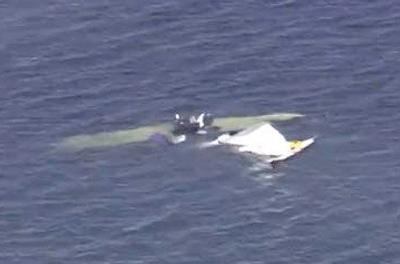Video Reviewed By The Board Showed Airplane In Steep Climbs, Descents And Turns At Low Altitude Before Impacting The Water
The NTSB has released its preliminary report from an accident involving an Icon A5 airplane that was being flown by former Major League Baseball Pitcher Roy Halladay on November 7. Halladay was fatally injured when the plane impacted shallow water in the Gulf of Mexico off the coast of Florida.

According to the report, about 1204 eastern standard time on the day of the accident, the airplane impacted open water in the Gulf of Mexico while maneuvering at low level near New Port Richey, Florida. The private pilot sustained fatal injuries, and the airplane was substantially damaged. The airplane was registered to N529PG LLC, and operated by the pilot on the VFR personal flight. Visual meteorological conditions prevailed at the time of the accident, and no flight plan was filed. The local area flight departed from a lake near the pilot's home in Odessa, Florida, about 1147.
The airplane was equipped with a digital data module that recorded basic GPS, engine, and flight parameters. The airplane was also equipped with a Rockwell Collins engine control unit that recorded engine parameters. The data track from the accident flight showed that the airplane departed from a private lakeside home north of Lake Keystone in Odessa about 1147 and climbed to a GPS altitude of 1,909 ft and tracked north for 4 miles before turning to the west toward the coastline. The airplane then flew for 10 miles and crossed over US Highway 19 about 600 ft GPS altitude, then descended to 36 ft over the water before turning south. The airplane then flew on southerly track past Green Key Beach at 11 ft GPS altitude and 92 knots.
The airplane then performed a right 360° turn while climbing to about 100 ft. The airplane continued on a southerly track, flying as close as 75 ft to the Gulf Harbor South Beach houses. The last data point recovered indicated the airplane at an altitude of 200 ft, a speed of 87 knots, and tracking 196°. Video footage taken of the airplane before the accident, shows the airplane in a descending left 45° banked turn and then maneuvering about 10 ft above the water. A witness to the accident stated, during an interview with a National Transportation Safety Board (NTSB) investigator, that he saw the airplane perform a climb to between 300 and 500 ft on a southerly heading and then turn and descend on an easterly heading about a 45° nose-down attitude. He then saw the airplane impact the water and nose over.

The airplane came to rest in 4.5 ft of saltwater oriented on a 192° heading with the fuselage and wings inverted. The front fuselage and cockpit were highly fragmented. The empennage section separated from the airframe and came to rest forward of the wings in an inverted position. Two inflated life vests and numerous fragments were recovered within a 300-ft radius from the wreckage. All the flight controls and major components were located at the main wreckage site. The CAP ballistic parachute system was not deployed, and the handle pin was installed. On November 8, 2017, the wreckage was recovered from the water and transported to a secure facility for further examination.
The airplane was a certificated light sport aircraft that was outfitted with a Rotax 912iS engine. The pilot accepted delivery of the airplane on October 10, 2017. The pilot's logbook indicated that he had logged a total of 703.9 flight hours, of which 51.8 hours were in an Icon A5 airplane, and 14.5 hours were in the accident airplane.
The closest weather reporting facility was the St. Pete-Clearwater International Airport (KPIE), about 19 miles southeast of the accident site. At 1153, a METAR from KPIE was reporting, in part: wind calm, visibility 10 statute miles, clouds and sky condition clear, temperature 83°F, dew point 67°F, altimeter 30.08 inches of mercury.
(Images of Halladay aircraft from file)
 SpaceX to Launch Inversion RAY Reentry Vehicle in Fall
SpaceX to Launch Inversion RAY Reentry Vehicle in Fall Aero-News: Quote of the Day (04.23.24)
Aero-News: Quote of the Day (04.23.24) Aero-News: Quote of the Day (04.20.24)
Aero-News: Quote of the Day (04.20.24) ANN's Daily Aero-Linx (04.20.24)
ANN's Daily Aero-Linx (04.20.24) Aero-News: Quote of the Day (04.21.24)
Aero-News: Quote of the Day (04.21.24)


